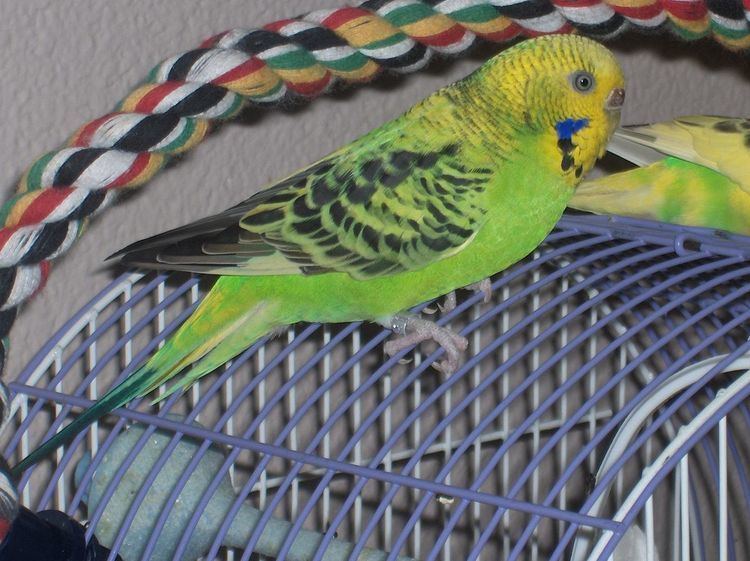 | ||
The Cinnamon budgerigar mutation is one of approximately 30 mutations affecting the colour of budgerigars. It is the underlying mutation of the Cinnamon variety and, with Ino, a constituent mutation of the Lacewing variety.
Contents
Appearance
All the markings which appear black or dark grey in the corresponding Normal appear brown in the Cinnamon, of a shade similar to that of white coffee. The Cinnamon markings on cocks tend to be considerably darker than on hens . The long tail feathers are lighter than Normals. The body colour and cheek patches are much paler, being about half the depth of colour of the Normal. The feathers of Cinnamons appear tighter than Normals, giving a silky appearance. It is these quiet pastel shades and the sleekness of the plumage that give the variety its appeal.
The eyes of the newly hatched Cinnamon are not black like the eyes of Normals, but deep plum-coloured. This colour can be seen through the skin before the eyes open , and immediately after opening a reddish-brown gleam can be seen. A few days later the eye darkens and is then barely distinguishable from that of a Normal chick, but by this time the difference in down colour is visible: Normal chicks have grey down, but Cinnamon (and Opaline and Ino) chicks have white.
The skin of Cinnamon chicks is also redder than Normal's, and this persists into adulthood: the feet of Cinnamons are always pink rather than bluey-grey. The beak tends to be more orange in colour.
Superficially, the Cinnamon is very like the two types of Fallow, the German Fallow and the English Fallow, but the eye of the Cinnamon is dark brown with white iris (except for the first few days after hatching, when it is purplish or plum-coloured) whereas the eyes of both varieties of Fallow are red at all ages. The body colour of the Cinnamon is also a rather deeper shade of green or blue than that of the Fallows.
Genetics
The Cinnamon mutation is sex-linked, the locus of its gene being carried on the Z chromosome, and recessive to wild-type. This was determined first by Mr Cyril H Rogers working with Mr Simms and Mr Porter. It was reported in the Budgerigar Bulletin as early as August 1933 , and in more detail in September 1934 . At the time of the first report a Cinnamon cock had never been bred. The first cock appeared late in 1933 as a result of a deliberate mating by Mr Porter of a Cinnamon hen and a split Cinnamon cock.
Cinnamon-like mutations are known in many other bird species, including the canary, greenfinch, peach-faced lovebird and cockatiel. All these Cinnamon mutations are sex-linked recessives.
The gene locus has the symbol cin. The wild-type allele at this locus is notated cin+ and the Cinnamon allele is notated cin.
In birds, the cock has two Z chromosomes and the hen has one Z and one W chromosome. So in hens whichever allele is present on the single Z chromosome is fully expressed in the phenotype. Hens cannot be split for Cinnamon (or any other sex-linked mutation). In cocks, because Cinnamon is recessive, the Cinnamon allele must be present on both Z chromosomes (homozygous) to be expressed in the phenotype. Cocks which are heterozygous for Cinnamon are identical to the corresponding Normal. Such birds are said to be split for Cinnamon, usually written '/cinnamon'.
The table on the right shows the appearance of all possible genetic combinations involving the Cinnamon mutation.
The Cinnamon gene is linked to other genes located on the X chromosome, i.e. to the genes of other sex-linked mutations. These sex-linked mutations include the Opaline, Ino and Slate mutations. The cross-over or recombination values between Cinnamon and these linked genes has not been measured accurately, but results collected by C Warner and T Daniels found 41 crossovers in 113 between Cinnamon and Opaline, giving a recombination ratio of 36±6%. The Ino gene is known to be very close to the Cinnamon gene; for details see the Ino budgerigar mutation.
C H Rogers, reporting early breeding results in 1939 , notes the breeding of Cinnamon Slates by Mr G W Roderick, of Purley and Mr L Trevallion of Loughton, Essex. The appearance of two Cinnamon Slates by 1939 suggests these two genes are not closely linked.
Cocks split for both Cinnamon and Opaline have one Cinnamon allele and one Opaline allele together with one each of the corresponding wild-type alleles. The linkage between the Cinnamon and Opaline genes gives rise to two types of split cinnamon opaline cocks, both visually identical.
Hens cannot be split for any sex-linked gene, so only cocks exist in Type I and Type II form.
